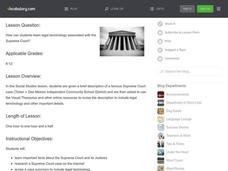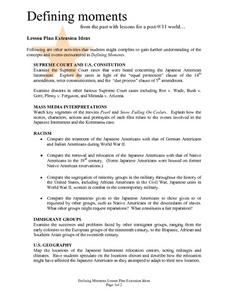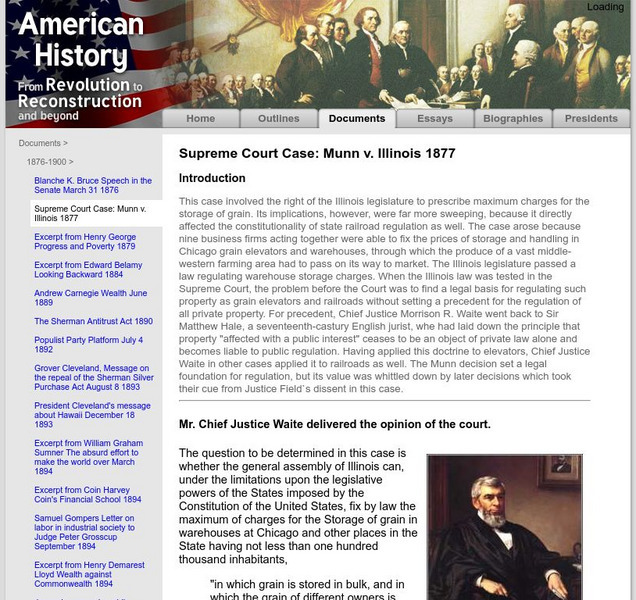DocsTeach
School Desegregation Court Cases: Mendez v. Westminster and Brown v. Board
Separate is not equal! Young historians analyze the petition from the U.S. Supreme Court case Mendez v. Westminster filed in 1945 and examine background material about the case. They then compare it to the more famous Brown v. Board of...
Curated OER
Words That Hold Court
Students recognize the importance of the Supreme Court. In this legal terminology lesson, students define a list of words to understand the Supreme Court and the language used in cases. Students revise a case summary.
Curated OER
Words That Hold Court
Students research legal terminology used in the Supreme Court. In this legal terminology lesson, students study a quote from President Obama about the Supreme Court. Students make a list of facts about the Supreme Court and the justices...
Curated OER
Boundary Crossing
Seventh graders explore the issues that arose as a result of boundary crossing. In this US History activity, 7th graders research supreme court cases in regards to crossing boundaries. Students present their findings to the...
Curated OER
The Formation and Function of the Supreme Court
Students analyze the role of the U.S. Supreme Court. They read a handout and Article III, section 1 of the Constitution, analyze and rate by relevance noteworthy Supreme Court cases, and write how they decided each rating.
Curated OER
Equal Protection Questions
In this Supreme Court worksheet, students respond to 14 short answer questions regarding equal protection and gay marriage issues in the United States.
Curated OER
Plessy V. Ferguson: "Separate but Equal," Equal Protection
Students explore the details and impact of the Plessy vs. Ferguson U.S. Supreme Court case. In this U.S. History lesson plan, students participate in several group discussions and group activities that examine both sides of the...
Curated OER
Defining moments from the past with lessons for a post-9/11 world...
Students examine extension ideas concerning 9/11, Defining Moments. They analyze a variety of Supreme Court cases, the U.S. Constitution, Mass Media Interpretations, Racism, Immigrant groups and U.S. geography. Many questions are asked...
Digital Public Library of America
A Raisin in the Sun by Lorraine Hansberry
A set of 14 primary sources provides background for a study of Lorraine Hansberry's drama, A Raisin in the Sun. Featured are images from stage productions of the play, white supremacy protests, a clip from a television interview, and...
Curated OER
A More Perfect Union: Barack Obama's Race Speech at the National Constitution Center
Eleventh graders explore the process of perfecting the Union through changes made to the Constitution, and through the powers delegated to each branch of government. In this American Government lesson, 11th graders research various...
Curated OER
The Constitution Lives! How it Protects Your Rights Today
Students brainstorm their rights as Americans. In this The Constitution Lives! lesson, students discern the difference between rights and rules by completing a worksheet. Students consider the differences between types of constitutional...
Soft Schools
Civil Rights
Informational text about the Civil Rights Movement challenges young historians to prove their reading comprehension skills with six multiple choice questions. After answers are submitted a new screen displays a score,...
Curated OER
Fill-In : March Events in the News
What happened on March 13, 1868? What happened on March 21, 1965? Eager readers fill in the missing historical event occurring on one day in March from 1862 - 1995. There are 31 events each occurring on a different day in March. This is...
Curated OER
America responds to Dred Scott
Eleventh graders examine the reactions Americans had to the Dred Scott decision. In this American History lesson, 11th graders read editorials from newspapers. Students analyze these editorials and audio tapes from that...
K5 Learning
Fight for Equality: Thurgood Marshall
Students read an informational text passage on Thurgood Marshall and his contribution to African Americans' rights, and then answer questions based on what they read.
Curated OER
US History
In this US History worksheet, students complete the crossword puzzle using the clues at the bottom of the page. There are 34 clues in total on this worksheet.
Curated OER
Legislative Branch (Congress) Questions
In this U. S. government worksheet, students respond to 10 short answer questions about the responsibilities of congressional members.
Education World
Every-Day Edit: Thurgood Marshall
For this editing activity, learners read and edit a paragraph about Thurgood Marshall, and find the 10 errors in capitalization, punctuation, spelling and/or grammar. Learners correct each error they find.
Curated OER
Society in the 1950s (5)
In this online interactive American history worksheet, students respond to 8 matching questions regarding 1950's America. Students may check their answers immediately.
Curated OER
Unsung Heroes of the Civil Rights Movement
Students analyze historic rulings that played roles in the Civil Rights Movement. In this civil right lesson, students research Internet and print sources regarding Plessy v. Ferguson, Sipuel v. Board of Regents of the University of...
Other
Landmark Supreme Court Cases
Excellent resources for teaching about landmark Supreme Court cases. Strategies include case study, moot court activity, role play, continuum, community resources, evaluating websites, and political cartoon analysis.
University of Groningen
American History: Documents: Supreme Court Case: Munn v. Illinois 1877
Content includes the complete text of the 1877 Supreme Court case of Munn v. Illinois dealing with corporate rates and agriculture.
University of Groningen
American History: Documents: The Marshall Cases: Marbury v. Madison
The text of the famous Supreme Court decision, Marbury v. Madison, is presented here.
PBS
Wnet: Thirteen: The Supreme Court: Landmark Cases: Schenck v. u.s. (1919)
PBS offers a summary of the landmark Supreme Court case of Schenck v. U.S. which dealt with when an individual's free speech rights under the First Amendment presented a "clear and present danger." This case has since been overturned.

























